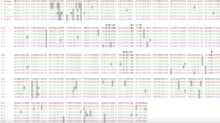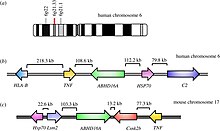User:Itzelhm97/BAT5
| This is the sandbox page where you will draft your initial Wikipedia contribution.
If you're starting a new article, you can develop it here until it's ready to go live. If you're working on improvements to an existing article, copy only one section at a time of the article to this sandbox to work on, and be sure to use an edit summary linking to the article you copied from. Do not copy over the entire article. You can find additional instructions here. Remember to save your work regularly using the "Publish page" button. (It just means 'save'; it will still be in the sandbox.) You can add bold formatting to your additions to differentiate them from existing content. |

Bat5 structure[edit]
Amino Acid Sequence[edit]
BAT5 (also known as ABHD16A) has been found to be 558 amino acid residues. It was fist identified in 1992 in the gene domain of NTFalpha and TNFbeta. BAT5 (ABHD 16A) in different species has been found to be different lengths of amino acid sequence.

BAT5 has been determined to be highly conserved when compared to human, mice and other mammalian ontologies[1]. It is found to be expressed in multiple different tissue cells. According to molecular evolutionary genetic analysis, in comparison of 13 mammalian species, the differences in amino acid sequence length is due to splicing in post transcriptional processing of mRNA.[2]

BAT5 gene location[edit]
Human Bat5 (ABHD16A) is located on chromosome 6. Mice Bat5 (ABHD 16A) is located between TNF and Heat shock protein near the Ck2b protein kinase gene. [3]
BAT5 molecular weight[edit]

BAT5 in humans and mice has been found to be around 63kDA.
Bat5 implications in recent studies[edit]
BAT5 has been linked to neurological, immune regulation, Kawasaki's disease and coronary artery disease.[4]
References[edit]
- ^ Savinainen, Juha R.; Patel, Jayendra Z.; Parkkari, Teija; Navia-Paldanius, Dina; Marjamaa, Joona J. T.; Laitinen, Tuomo; Nevalainen, Tapio; Laitinen, Jarmo T. (2014-10-07). "Biochemical and Pharmacological Characterization of the Human Lymphocyte Antigen B-Associated Transcript 5 (BAT5/ABHD16A)". PLOS ONE. 9 (10): e109869. doi:10.1371/journal.pone.0109869. ISSN 1932-6203.
{{cite journal}}: CS1 maint: unflagged free DOI (link) - ^ Xu, Jun; Gu, Weizhen; Ji, Kai; Xu, Zhao; Zhu, Haihua; Zheng, Wenming. "Sequence analysis and structure prediction of ABHD16A and the roles of the ABHD family members in human disease". Open Biology. 8 (5): 180017. doi:10.1098/rsob.180017. PMC 5990648. PMID 29794032.
{{cite journal}}: CS1 maint: PMC format (link) - ^ Xu, Jun; Gu, Weizhen; Ji, Kai; Xu, Zhao; Zhu, Haihua; Zheng, Wenming. "Sequence analysis and structure prediction of ABHD16A and the roles of the ABHD family members in human disease". Open Biology. 8 (5): 180017. doi:10.1098/rsob.180017. PMC 5990648. PMID 29794032.
{{cite journal}}: CS1 maint: PMC format (link) - ^ Xu, Jun; Gu, Weizhen; Ji, Kai; Xu, Zhao; Zhu, Haihua; Zheng, Wenming. "Sequence analysis and structure prediction of ABHD16A and the roles of the ABHD family members in human disease". Open Biology. 8 (5): 180017. doi:10.1098/rsob.180017. PMC 5990648. PMID 29794032.
{{cite journal}}: CS1 maint: PMC format (link)
